Sales Package:
- Handset
- 730 mAh Li-Ion battery
- Charger
- Corded stereo headset HHS-150
- User guide
Before going bankrupt BenQ Mobile realized that apart from fine words on taking over the market it lacked solid products, which could turn over mostly negative reputation of the brand. The main reasons were domination of high-quality yet budget solutions and missing balanced models aiming for mid- and high price-brackets. The developers were in fact challenged by time itself, as their task was to release such offerings and publicly demonstrate that the brand of Siemens deserved being alive, even if it was a subsidiary of BenQ. Ridiculous it might sound, but the engineers succeeded in doing so, while the marketing department spoiled everything – not a big surprise here, though

The main drawback reported by customers is malfunctioning software on many devices, which has been the bad reputation builder for Siemens over the past few years and sales reducer as well. Over at the company they decided to give up modern trends and develop new models basing off the proven SGold2 platform, which also allowed coming up with flawlessly running software. BenQ Siemens E71 was meant to be one of the heroes bringing the company back to life. Why do we mention it in the past tense? Unfortunately, the general state affairs in the company inevitably lead to the situation when the device will be picked by sophisticated users, rather than the masses, and besides the stock in Russian and European distributors’ warehouses is very limited.

The way the model is design is quite unusual, as the company was setting out to launch a «killer» handsets coming in classic shapes, so eventually the designers have done considerable amount of work. One of the latest-and-greatest market trends today is equipping phones with glass-like surfaces. Remember the mirror-finished Motorola KRZR K1, Sony Ericsson Z610i with external glassy surface and Alcatel OT C750, a “liquid” metal candy-bar. Taking into the account low spreading of Alcatel’s solutions, BenQ-Siemens E71 gets to be the only bar-shaped handset sporting suck looks on the market, or at least in its niche. The casing is by no means made of metal – unique plastic fishing is used instead, however the model coming inn Dark Silver color scheme the E71 seems somewhat similar to “liquid” metal, while the Black Onyx presents you with black lacquered plastic, which appears to be nothing special against the background of already released products. However there is a significant difference – the plastic applied here was used only on more expensive solutions rather than mid-range handsets.
Video – appearance of the device (wmv, 3.5 mb)>>>


Both trims get soiled in no time – it’s the drawback of all glossy surfaces, as they always keep your fingerprints, which are hard to deal with. The casing isn’t afraid of scratches, provided that they don’t go too deep into the shell (0,5 mm is enough). Having scratched the casing this deep you are likely to get surface coming off around it. I should stress it again that should you manage the handset will all due care, such issues will be non-existent.
The E71 measures a very comfortable 104õ46õ15 mm. Pay your attention to the thickness, as it is definitely not a «slim» solution, nevertheless the device is really tiny throughout its thickness, which adds to its look-and-feel qualities and usability. It will easily slip into both your shirt’s or jeans’ pocket. The handset weights 80 grams.
Video, appearance of the device, comparison of dimensions, menu layout (wmv, 18.1 Mb)>>>


As for its feature-pack, the device turns out to be a replica of the slider-style BenQ Siemens EL71, boasting exactly the same display. As a matter of fact this display is one the best in its market niche nowadays, whereas in this price-bracket it’s a truly brilliant offering. The screen shows off QVGA resolution (240õ320 pixels, 31õ42 mm, 2 inches), and is capable of displaying up to 262 K colors (TFT). Due to the re-worked interface and the main menu’s icons, the final favorable impression of the display’s prowess gets much stronger. Information displayed on the screen remains readable in the sun; the right angle makes all the difference here. The fonts are quite large - you will be offered up to 8 text lines and 3 service lines (SMS input mode, normal font size). Zoom feature is also on-board – using this you can either enlarge font size or make it smaller. At any rate the difference seemingly comes to a single line in either case. The display is handy and doesn’t have any outstanding specifications.
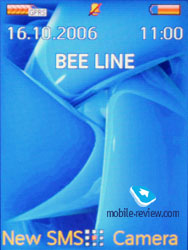
The handset retains a plastic keypad that might creak sometimes at “heavy-duty” clicks but the buttons don’t knock loose and keep the initial state as time goes by. The keypad ergonomics is average or a bit better – it is not inconvenient of something, I would rather call it “up to the standards”. The Four-way navigation button has OK key inserted into it. The keys are lit in a white, which is readily distinguishable in various types of environment.



The left side panel holds a double key of volume control; the upper end features holes for a carrying strap. The lower rim houses Nano interface slot (no surprises here), used for connecting either a headset or a charger. On the rear you can see a bordered 1.3 Mpix camera’s lens– most devices retain Samsung’s module (red tinted lens).




The build quality of the casing is pretty good - in the beginning it’s rather challenging to slide open and close the back cover due to tightly adjusted parts. With time the process becomes easier, although the cover doesn’t get any gap. Quality of the battery cover found on the devices coming from the very first shipments was worse – gap was easy to find.

The handset carries 17.5 Mb of user-manageable memory onboard, with its size depending on number of pre-installed applications, so for most markets the final storage volume will make about 16 Mb. The phone also has a slot for microSD (TransFlash) memory cards, though hot swap trick won’t work here – to change memory card you will have to take out the battery. The slot is allocated near the SIM-card’s bed.

The battery applied to this model is Li-Ion with the capacity of 730 mAh. The manufacturer claims 390 hours of life time in standby and up to 6 hours of talk time. Though in practice, the charge lasted for approximately 2 days on an hour of callsand up to 50 minutes of other functions use. As compared with BenQ Siemens EL71 the lifetime has increased by about 50-60 percent, so that the handset can be used for two days on a single charge and for about three days should you be easy on its functionality. Full recharge time of the battery has been reduced to 1.5 hours, as the standard charger makes use of higher amperage.
Menu
The first prototypes of the E71 were similar in menu and appearance to the EL71, but having arrived in the market the handset’s interface has been modified significantly: it has obtained own icons, screensavers and themes. This is another proof of how serious BenQ Siemens thought about the development of this offering. In my opinion that’s one of the best handsets in their market niche in the sense the range of applications, content and its quality. For example the theme from the Ice Age II will perfectly suit the audience the handset targets at.
Video, handset’s menu and Ice Age II game (wmv, 3.5 Mb))>>>



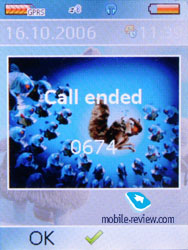
The device represents the same family as Siemens S75 and Siemens S68, but differs in the way several functions work and distinct software kit. The interface has also been re-worked for the better; to be precise the icons look way better, what adds some more points to the handset. The main menu has an appearance of a 3x4 grid with fast number navigation function provided. By tradition you are at liberty to make up a My Menu of your own. Besides a standard variety of functions, numeric keys may be assigned to a certain telephone number, so here you will have to choose one of two options, whether to tie it up with a function or with a contact. In some functions and menus tabs system rules the roost, which can be switched between by horizontal declinations of the navigation key.

Phonebook. The device’s phonebook is capable of storing up to 1000 entries. For each contact you can submit four telephone numbers, two fax numbers, for e-mail addresses, two page URLs, company’s name, etc. At that the phone numbers are displayed in a separate window, while fax numbers are located in private and business tabs. At the beginning of the general list the phone shows entries on English language, and after these – all contacts with the title names on all other languages. Each contact may be tied to a nickname, though in this case its place in the list will depend on the language, the main name of the contact was written on – so an English nickname may end up in the part containing only Russian entries.
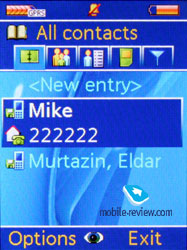
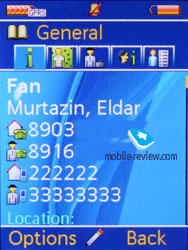
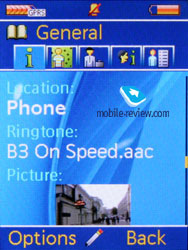
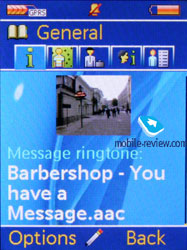


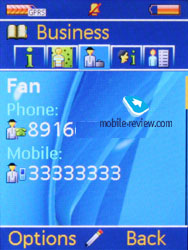
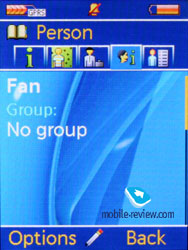
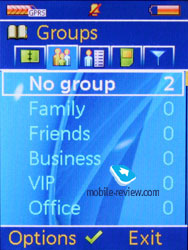



Among personal settings for each contact, one can set a particular ring tone, image, group, and birthday date. Each contact may be tied up with a video clip, which will be played back on an incoming call. Entries, stored on SIM-card may be browsed in a special menu item. By default user is able to operate with 10 groups, one of which bears the name of “Not in a group”, this means all groupless contacts find their place here. No new groups can be created; each existing one can be bound up with a ring tone and a personal image.
All contacts may be sorted by e-mail, page URL, birthday or by mailing list, even more, all sorted entries are displayed in a separate window. No filters for various groups of contacts are available. The last used filter is always applied on every start up. It seems voice dial was striked off the short list of functions and as a result it isn’t featured in the phone.
In phonebook’s settings you can select general list’s sorting type (by first name or last name), assign fields which will be displayed behind each tab etc. On the whole the capabilities of these applications are very wide and give a lot of pleasing moments even to the most demanding consumer.
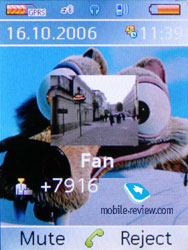
Call record. Up to 100 entries are stored in the memory of each call type – incoming, outgoing and missed. All calls are shown in common list too, with special icons for easier understanding. For each record you can see detailed information (date and time). Traditionally here you can find settings for call costs and time limitations; this requires entering PIN-code.
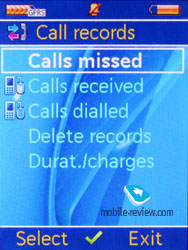
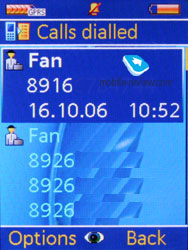
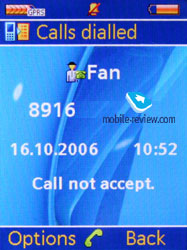
Internet. The phone has WEB-browser which supports HTML protocol. In case with English pages it’s almost okay, meanwhile Russian encoding causes significant problems, and it is becoming a “good” trend for the company. Files and applications uploading can’t be switched to background mode – you just won’t be able to minimize the corresponding window, as it is realized on handsets by Motorola, Sony Ericsson. Of pleasing things I am to make a note of automatic addresses saving – when you start typing an URL, the device will offer you a list of the last visited pages. If you are not completely satisfied with the capacity provided by the default browser, I strongly recommend installing Opera Mini – one of the best clients out there.
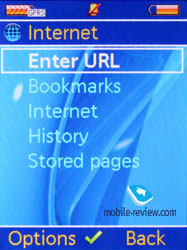
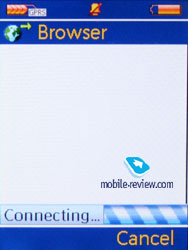
Messaging. Three types of messages can be created – SMS, MMS and E-mail. When you are creating SMS messages, you can type long compositions since joined message system is supported, maximal length is 755 symbols of latin font and up to 330 for cyrilics. Extended modes are not supported; you can only insert text template or contact from the phone book. T9 dictionary without word auto match function is supported. The words that are not present in the database can be saved afterwards. Next time they will be used, and basically they get easily recognized. Traditionally, this phone supports text line the letters for the button you are pressing, however another tradition was kept as well, and Russian letters do not match the common layout for most phones.


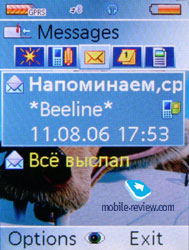
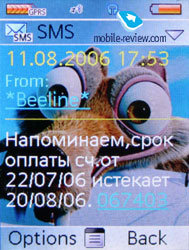
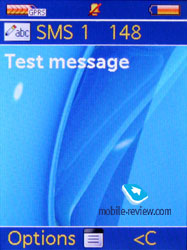



While creating a new SMS user can insert various text templates, entries from the phonebook, organizer, and also music files or video clips. Depending on the added content, a message may transform into a MMS.
A photo, text, video, sound and contact can be inserted into MMS message; this means that all basic functions are present. Photo and video recording can be done directly from MMS editing menu. Maximal size for MMS message is 195kb. Besides you can limit MMS by 95kb (a lot of network operators are limiting the size by 100kb), another separate option – maximal size allowed by network operator.
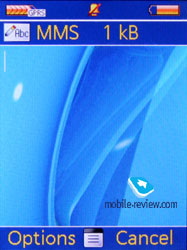
Ïðè ñîçäàíèè ñîîáùåíèÿ ýëåêòðîííîé ïî÷òû â îáÿçàòåëüíîì ïîðÿäêå äîëæåí áûòü ñîçäàí ïðîôèëü, èíà÷å ïóíêò ñîçäàíèÿ ýëåêòðîííîãî ïèñüìà ïðîñòî íå îòêðîåòñÿ. Ïî÷òîâûé êëèåíò ïîääåðæèâàåò ïðîòîêîëû SMTP, POP3, IMAP4.  êà÷åñòâå âëîæåíèé ìîãóò âûñòóïàòü äàæå íåïîääåðæèâàåìûå òèïû ôàéëîâ. Ìàêñèìàëüíûé îáúåì âëîæåíèé íå ìîæåò ïðåâûøàòü 10 Ìá. Ðóññêèå êîäèðîâêè ïîääåðæèâàþòñÿ íåêîððåêòíî. Ïðè ñîõðàíåíèè ñîîáùåíèé èñïîëüçóåòñÿ ïàìÿòü òåëåôîíà è îòäåëüíûé ñëîò ïîä ïî÷òó, çäåñü îí ñîñòàâëÿåò îêîëî 1 Ìá, ÷òî íå ïîçâîëÿåò ðàññìàòðèâàòü äàííóþ ôóíêöèþ ñåðüåçíî. Åìêîñòü êàðòû ïàìÿòè ïðè ýòîì íå çàäåéñòâóåòñÿ.
There aren’t any preset templates, you should create them yourself. These templates can be used as headings or signature for your message. Settings for voice mail can be found in the same menu.
Organizer consists of calendar, voice memos, world time settings and synchronization point.
The Calendar is displayed in monthly view by default – all dates which have assigned tasks are shaded. Having selected one of those dates, you will see how the bottom of the screen gets filled up with appointments, which can be instantly browsed. The other view type is weekly one, featuring hourly timetable – one can set start time for any day, choose which days are working ones and which are not. Considering the pleasing fact that all birthdays are automatically directed to the Calendar, the developers provided a function for turning off their appearance on the general list.
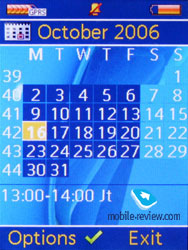
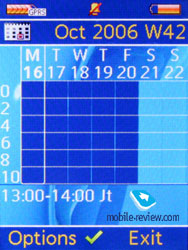

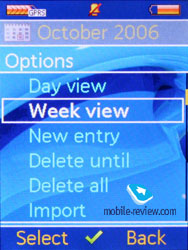
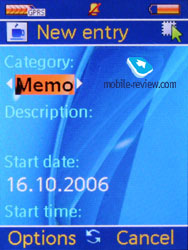
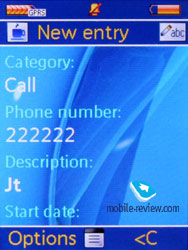
Each event in the Calendar is tied up with a theme, stand and end dates, alarm triggering time (if needed). Next thing you can adjust is reoccurrence (daily, weekly, monthly, yearly, never). Number of entries is limited only to the size of available storage (organizer is capable of using nearly 9 Mb, though in practice we figured out it can accept more than 500 events). Apart text notes you can create events with voice messages.
To-do list almost completely copies entries in the Calendar – the only single difference lies in competition status (done or not) and priority level (5 scales, starting from the highest one and ending with the minor level). End date and alarm clock are easily set via corresponding options. The to-do list doesn’t have Reoccurrence option.
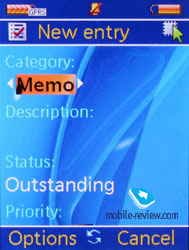
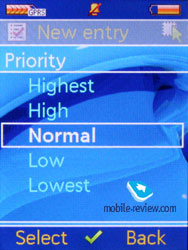
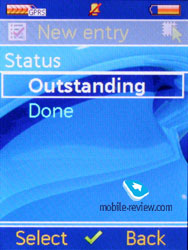
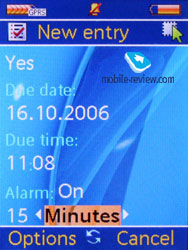
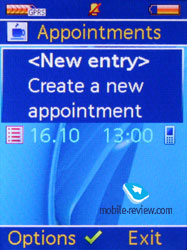
Notes – simple text notes, entered by user. You can create a special folder with private notes, which can be accessed only in case you know the password.
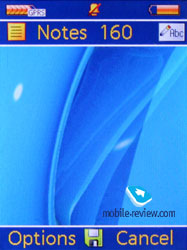
The World time function seems to remain the same from one handsets generation to another. You can check out difference in time between two selected cities.
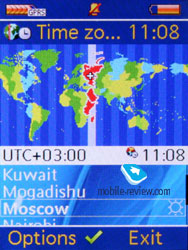
«Synchronization» provides the possibility of setting up corresponding profiles, selecting applications, choosing type of data transfer. The developers have also incorporated capability for using external servers for storing contacts and calendar events (SyncML protocol). Synchronization with a remote site is carried out without any nuisances.
Alarm clock. The handset has only one alarm clock on-boards, which can be set to certain days of week, playing various tunes and enabled to use Autosnooze. Not a single extra feature can be found here.
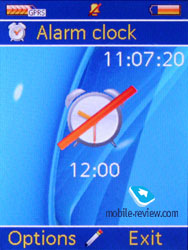
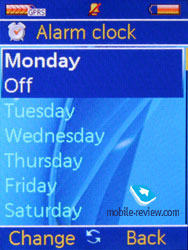
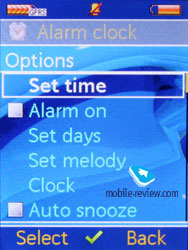
Games. Number of pre-installed games may vary depending on given region – e.g. the Russian users will find a new game installed in the phone – Brick Challenge (kind of arcanoid), Ice Age II (arcade, pleasant enough), Sudoku.
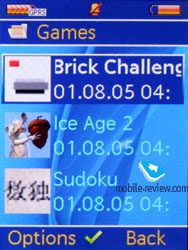
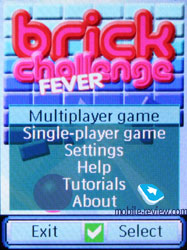
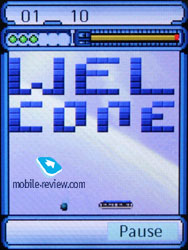



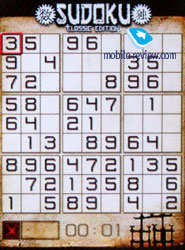
Media player. The general concept of the player is similar to 75-series – to be precise, the media player embedded in the EL71 features four tabs, the first one displays all music files (when uploading new tracks, you better refresh the entire list, as the phone looks for music everywhere), the other tab holds playlists, the third bookmark shows all images, while the last one plays back video clips. The device supports the following formats: MP3, AAC, MIDI, AAC, AAC+, AAC++, AMR-NB, PCM(WAV), SP-MIDI, XMF. As for formats which videos can be stored in – the handset offers both 3GP and mpeg4 with the possibility of setting playback to full-screen mode.


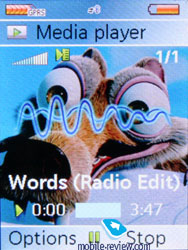
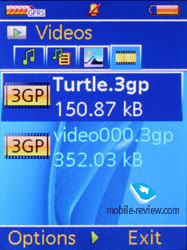


On an incoming call, the media player automatically pauses and once you hang up, continues playback from exactly the same point where it was interrupted. the phone is armed with Shuffle function. The player may be minimized, however neither track’s title nor remaining time are not displayed on the home screen. The functionality of the given media player is rather poor as compared to products by some other manufacturers – it’s just a set of basic functions with no extras.
Radio.It is arranged as a detached Java-application, which blocks minimization feature. Your personal radio stations can be settled, but the application lacks both RDS and auto tuning. Using headset from the package you may switch settled radio stations by tense retention of the button.
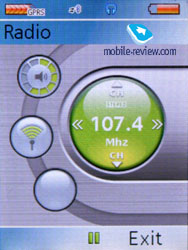
Extras. Here a few items found their home – the first of which is “My applications”, where pre-installed utility, namely MobiPocket Reader (book reading software), MoonCalendar, News2Mobile (RSS-client). Well sorted out range of programs.
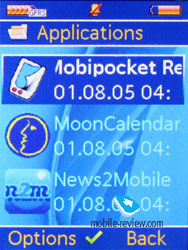
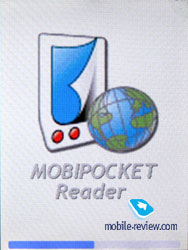

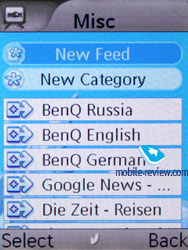

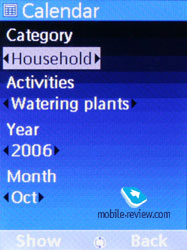
Calculator. It has extended abilities, like exponent calculation, square root and reciprocal. One of the options is simple unit converter, however there is another way to launch it, separate option.
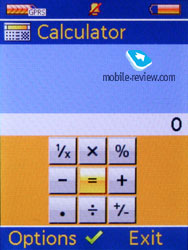

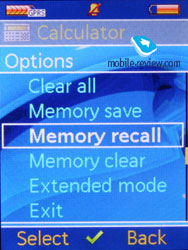
Sound recorder. Dictaphone, placed in this menu item, is re-named to “Voice reminder” – total length of recording is 100 hours. The function also operates in course of a telephone conversation, in this case you will need to call it up through the main menu – regrettably there is no special fast access key for it (even if you assign one of the side keys, it just won’t start up). Calls recordings are labeled similarly to all other files – namely you won’t see contact’s number or name if you have him on your contact list. While the dictaphone is working, usage of all other functions is restricted – you can neither use the keypad nor do any other actions, so should your interlocutor hang up, the voice recorder won’t turn off, therefore you will be forced to do this manually.
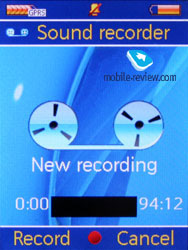
Stopwatch. Allows measuring time periods with intermediate results (up to 100).
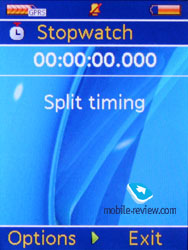
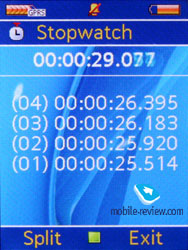
Countdown time is extended owing to provided sub-settings for cooking eggs, rice, potato etc.
Unit converter – allows converting one units into others.
My stuff. Traditional File Manager from Siemens. Besides simple folders with graphics, video and themes/sounds, folder with games and applications is displayed here as well. As always, file system is easily managed – you are at liberty to move around both folders and files, copy information taken from them back and forth. Memory card owns its own specialized tab. The application conducts search by name, type and creation date.
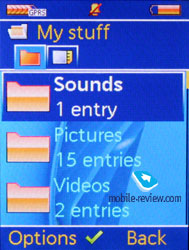
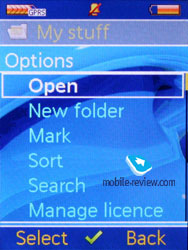
Settings. Behind this tab you will find profiles with flexible options – e.g. you can select tunes for every single event, starting with incoming calls and messaged and finishing with organizer and other functions. Vibration alarm has various modes, which are also completely adjustable.
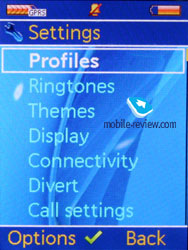
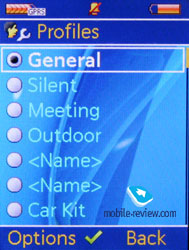
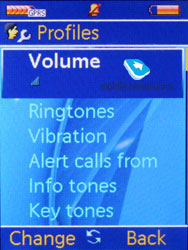
The handset possesses the function of turning off on the schedule. But what is more interesting, when pressing power button while at standby screen, the device offers you either to just switch it off or cancel all alerts and scheduled tasks along with turning off, or simply deactivate all sound alarms without shutting off the device.
The same menu houses EDGE and Bluetooth settings, quite “so-so”.
Camera. The handset is equipped with a 1.3 Mpix camera, which is not a satisfactory judging by the current competition level, but this manufacturer has always been well disposed towards incorporating low-resolution camera modules into fashion handsets. The module itself is produced by Samsung, similar to those, Siemens S75 are armed with (the camera is slightly better than that made by OmniVision in the first place).
The maximum resolution of a shot is 1280õ1024 pixels at 250-330 Kb per image. The truth should be told – on the handset’s display all pictures look fine, yet on PC they are of moderate quality, as usual though. The camera is capable of applying 5x digital zoom – when reaching the last scale on the zoom bar, shot’s size decreases to 110-150 Kb with image sharpness going down as well. At maximum resolution you are able to use these special effects: Sepia, gradations of grey, green, orange and purple. As you are decreasing zoom value, the effects pool is extended with Emboss. All taken photos may be saved both in handset’s memory and memory card. White balance has three options to choose from – auto, outdoor and indoor. Night mode and flash setup are also on place. Talking of image resolution, again you will need to guess about them, as the developers have applied labels, that don’t bear much of semantic load – premium (1280õ1024), high (640õ480), medium (320õ240), low (160õ120), wallpaper (132õ176). Pictures, which are aimed at applying to contacts in the phonebook later on are saved in the lowest quality. Resolution may be inspected only via file’s attributes.
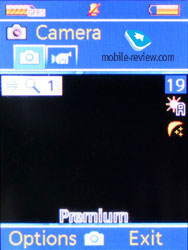
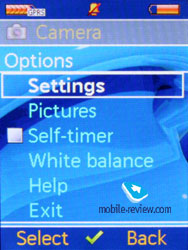

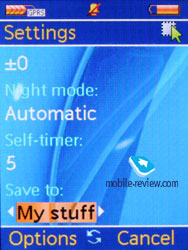
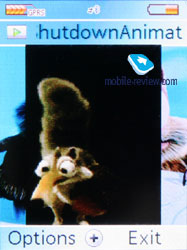

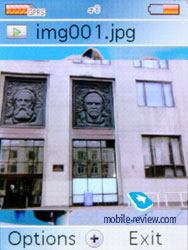
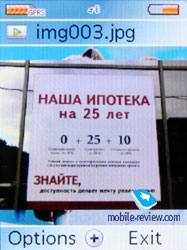
The EL71 lacks multishot mode, as well as capacity of shooting fast moving objects, since the device cannot provide the required shutter and processing speed.
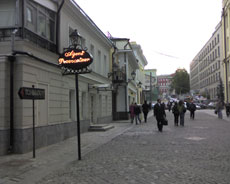 |
 |
(+)
maximize, 1280õ1024, JPEG |
(+)
maximize, 1280õ1024, JPEG |
 |
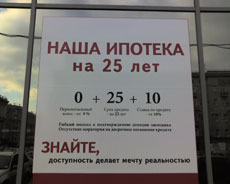 |
(+)
maximize, 1280õ1024, JPEG |
(+)
maximize, 1280õ1024, JPEG |
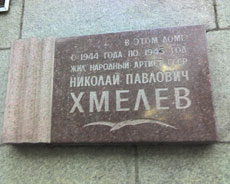 |
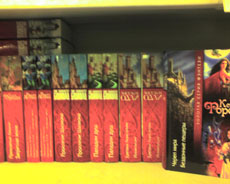 |
(+)
maximize, 1280õ1024, JPEG |
(+)
maximize, 1280õ1024, JPEG |
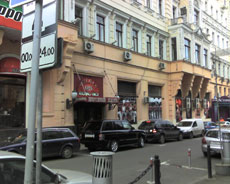 |
 |
(+)
maximize, 1280õ1024, JPEG |
(+)
maximize, 1280õ1024, JPEG |
 |
 |
(+)
maximize, 1280õ1024, JPEG |
(+)
maximize, 1280õ1024, JPEG |
Video recording. Length of a video clip directly depends on available storage back in handset’s memory or on memory cards; still it can’t exceed the value of 1 hour 30 minutes. With regard to extras, there one will discover setting for recording clips aimed at attaching short or long MMS messages. Size wise these two types differ a lot – the short one takes up 93 Kb and the long recording occupies 293 Kb. While already recording a video, you may either turn the sound off or on. White balance is adjusted without any efforts on your part, yet you can handle this parameter yourself. Similar to single shot mode, you need to guess about resolution judging by inexpressive titles - premium stands for 176x144 pixels, 129x96 pixels resolution is marked as normal. While shooting video, you can apply digital zoom and brightness control. Any stored video clip may be switched to full screen mode – the handset easily recognizes and plays back files, recorded with the help of any external device. The built-in flash serves as a flashlight as well.
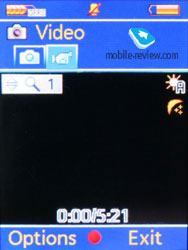
Performance. The handset bases off Siemens S75 core, but due to increased resolution and the CPU, which has been handed down from the predecessor, it doesn’t come up with extreme performance, and demonstrates worse results in course of the tests. On the whole, the performance yields to other devices representing the new generation, manufactured by other companies.
JBenchmark 1 |
| Total Score: |
1981 |
|
|
| Details: |
|
| Text |
723 |
| 2D Shapes |
534 |
| 3D Shapes |
221 |
| Fill Rate |
95 |
| Animation |
408 |
|
|
| Screen Width |
240 |
| Screen Height |
320 |
| Color Screen |
true |
| Number of Colors |
65536 |
| Double Buffer |
true |
| Total Memory |
3670016 |
| Free Memory |
1990404 |
|
|
| MicroEdition Configuration |
CLDC-1.1 |
| MicroEdition Profiles: |
MIDP-2.0 |
| Microedition Platform: |
SIE-E71/37 |
Jbenchmark 2 |
|
|
| Total Score: |
138 |
|
|
| Details: |
|
| Image Manipulation |
122 |
| Text |
196 |
| Sprites |
241 |
| 3D Transform |
143 |
| User Interface |
59 |
|
|
| Screen (canvas) Width |
240 |
| Screen (canvas) Height |
264 |
| Color Screen |
true |
| Number of Colors |
65536 |
| JPEG Support |
true |
| Double Buffer |
true |
| Total Memory |
3670016 |
| Free Memory |
1698920 |
|
|
| MicroEdition Configuration |
CLDC-1.1 |
| MicroEdition Profiles: |
MIDP 2.0 |
| Microedition Platform: |
SIE-E71/37 |
Jbenchmark 3D |
| Perfomance |
|
| Jbenchmark3D HQ: |
112 |
| Jbenchmark3D LQ: |
147 |
| Triangles ps: |
14597 |
| kTexes ps: |
1114 |
|
|
| version: |
3.1.0 |
|
|
| Screen(canvas)width: |
240 |
| Screen(canvas)height: |
320 |
|
|
| 3D Subsystem: |
|
| M3G Version: |
1.1 |
| Antialaising: |
false |
| True color: |
false |
| Dithering: |
false |
| Mipmapping: |
true |
| Perspective correction: |
true |
| Local camera lighting: |
false |
| Max lights: |
8 |
| Max Viewport dimensions: |
1024 |
| Max Texture Dimensions: |
1024 |
| Max Sprite Crop Dimensions: |
1024 |
| Max Transforms Per Vertex: |
32 |
| Number of Texture Units: |
2 |
|
|
| Other properties |
|
| Color Screen |
true |
| Number of colors |
65536 |
| Transparency (alpha level) |
256 |
| Double buffer |
true |
| Total memory: |
1024 |
| Free memory: |
1024 |
|
|
| MicroEdition Configuration |
CLDC-1.1 |
| MicroEdition Profiles: |
MIDP 2.0 |
| Microedition Platform: |
SIE-E71/37 |
| Microedition Encoding: |
ISO-8859-1 |
| Microedition Locale |
en |
| Microedition Communication ports: |
COM0 |
| Microedition Hostname: |
null |
Impressions
The reception quality of the device is beyond question, ringtones are heard in almost any environment, while the 64-tone polyphony steps aside at the sight of mass MP3 tunes use. Compared to BenQ Siemens EL71 the volume has been reduced a bit, which allows eliminating crackling noises of the loudspeaker. Pre-set ring tones are of some interest – the device wins some points owing to their splendid sounding. The silent alert’s strength is above average – on flat surfaces the device is more likely to start moving around. Various profiles allow adjusting the alarm to your own tastes – on the whole this function is implemented very well.

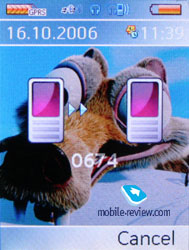

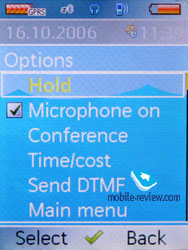

Reviewing the major drawbacks of BenQ handsets, to be more precise those handed down from Siemens old models, we need to stress Java-applications processing, and unavailability of working with them in background mode. Absence of this possibility leaves JIMM out of the game, or such common thing with other mobile phones, when you minimize application on an incoming call and then just continue working with it after hanging up. There is no way you can download Java-applications from other phones – WAP and PC synch take over this task. This limitation may become critical for a share of people, seeking for fully functional product, with the capability of extending its potential even further; and as regards the other group of consumers, it won’t make all the difference. It’s important to remember that similarly to the S75, the Java-engine has been renewed in almost every possible way, consequently you won’t find support for MIDP 1.0 on the handset, and in light of this fact you will be unable to install many applications and games.
Sound quality delivered by the out-of-the-box headphones is average, so if you go for this handset for the sake of music alone you should better fork out and by extra earphones with an adapter for them – just not to spoil the overall impression. If you listen to the music from time to time, then the default earphones will do. The player carried by the E71m yields to the majority of up-to-date, solutions but still provides the very minimum level of comfort and is packed with all basic functions. The greatest flaw here is inability of radio to work in background mode – it always stays on top.
Users often complain about the poor quality of shots taken with the handset’s camera. Though, it’s more about costumers’ expectations rather than the poorness of camera itself. Nowadays the matrix found here can’t put up a priori good, being a budget solution with all the ensuing consequences. The camera here is used to provide the user with on-screen viewing experience, rather than to allow him watching taken snaps on PC.
The best thing about the device is its stable firmware which doesn’t tend to reboot every five minutes. The truth is, there are small flaws as well, but most of users will overlook them.
So at the end of the day, the E71, going for 250 USD, boasts remarkable design, comfortable dimensions and all attributes of a modern handset – music player, radio, camera, etc. It would be wrong to call this device perfect, for example the music apps are the ones to blame. But taking into account the segment’s best screen good content, it won’t be a mistake to consider the E71 handset as a balanced solution both for youth and older people, especially women. Moreover, it outdoes nearly all candy-bar phones on the market today – it’s sufficient to say that its closest rival, Samsung X700 is inferior in the quality of the display and some features as well as design (the models has long since been outdated).
BenQ Siemens would make a comeback to the market, if only the company was prompt enough to release this model earlier, as well as its siblings for higher price-brackets. But they have come short of time and now the company is a bankrupt. As a result price for BenQ Siemens E71 won’t be going doing too much, as if was in case of mass production – the prices will be revolving at a relatively high level, so don’t expect drastic price-drops (unless the company’ assets stat getting sold by auction). By this moment BenQ Siemens EL71 has already left the shelves of retail stores in some countries, so the same scenario is possible for the E71 model. We strongly recommend you to pay your attention to the E71, as long as it’s still in stock, since this device does really good as a phone for youth.
SAR value for this mode – 0.78 W/kg.




















































































































